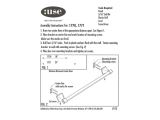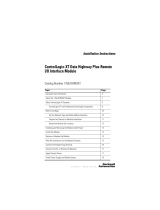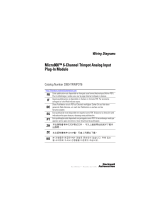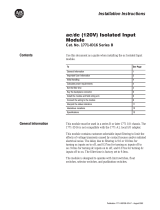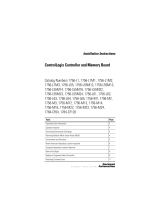Page is loading ...

Installation Instructions
Process Remote I/O (RIO) Communication
Interface Module
Catalog Number 1757-ABRIO
About This Publication
Use this publication as a guide to install the Process Remote I/O (RIO)
Communication Interface Module. Refer to publication
1757-UM007C, the
1757-ABRIO User Manual, for additional information. You can download a
.pdf file of the manual at:
http://literature.rockwellautomation.com.
Topic Page
Important User Information 2
Environment and Enclosure 3
North American Hazardous Location Approval 4
Prevent Electrostatic Discharge 5
Identify Module Features 5
Prepare the Chassis for Module Installation 6
Remove and Insertion Under Power 6
Install the Module 7
Wire the Connector for the Remote I/O Network 8
Status Display Power-up Messages 9
Interpret the Alphanumeric Display 10
Interpret the Status Indicators 11
Configuring the Module 12
Specifications 13
Additional Resources 15

2 Process Remote I/O (RIO) Communication Interface Module
Publication
1757-IN916C-EN-P - March 2008
Important User Information
Solid state equipment has operational characteristics differing from those of electromechanical
equipment. Safety Guidelines for the Application, Installation and Maintenance of Solid State Controls
(publication SGI-1.1 available from your local Rockwell Automation sales office or online at
http://literature.rockwellautomation.com
) describes some important differences between solid state
equipment and hard-wired electromechanical devices. Because of this difference, and also because of the
wide variety of uses for solid state equipment, all persons responsible for applying this equipment must
satisfy themselves that each intended application of this equipment is acceptable.
In no event will Rockwell Automation, Inc. be responsible or liable for indirect or consequential damages
resulting from the use or application of this equipment.
The examples and diagrams in this manual are included solely for illustrative purposes. Because of the
many variables and requirements associated with any particular installation, Rockwell Automation, Inc.
cannot assume responsibility or liability for actual use based on the examples and diagrams.
No patent liability is assumed by Rockwell Automation, Inc. with respect to use of information, circuits,
equipment, or software described in this manual.
Reproduction of the contents of this manual, in whole or in part, without written permission of Rockwell
Automation, Inc., is prohibited.
Throughout this manual, when necessary, we use notes to make you aware of safety considerations.
WARNING
Identifies information about practices or circumstances that can cause an explosion in
a hazardous environment, which may lead to personal injury or death, property damage,
or economic loss.
IMPORTANT
Identifies information that is critical for successful application and understanding of the
product.
ATTENTION
Identifies information about practices or circumstances that can lead to personal injury
or death, property damage, or economic loss. Attentions help you to identify a hazard,
avoid a hazard and recognize the consequences.
SHOCK HAZ-
Labels may be on or inside the equipment, such as a drive or motor, to alert people that
dangerous voltage may be present.
B
URN HAZARD
Labels may be on or inside the equipment, such as a drive or motor, to alert people that
surfaces may reach dangerous temperatures.

Process Remote I/O (RIO) Communication Interface Module 3
Publication
1757-IN916C-EN-P - March 2008
Environment and Enclosure
ATTENTION
This equipment is intended for use in a Pollution Degree 2 industrial
environment, in overvoltage Category II applications (as defined in IEC
publication 60664-1), at altitudes up to 2000 m (6561 ft) without
derating.
This equipment is considered Group 1, Class A industrial equipment
according to IEC/CISPR Publication 11. Without appropriate
precautions, there may be potential difficulties ensuring
electromagnetic compatibility in other environments due to
conducted as well as radiated disturbance.
This equipment is supplied as open-type equipment. It must be
mounted within an enclosure that is suitably designed for those
specific environmental conditions that will be present and
appropriately designed to prevent personal injury resulting from
accessibility to live parts. The enclosure must have suitable
flame-retardant properties to prevent or minimize the spread of flame,
complying with a flame spread rating of 5VA, V2, V1, V0 (or
equivalent) if non-metallic. The interior of the enclosure must be
accessible only by the use of a tool. Subsequent sections of this
publication may contain additional information regarding specific
enclosure type ratings that are required to comply with certain
product safety certifications.
In addition to this publication, see:
• Industrial Automation Wiring and Grounding Guidelines, for additional
installation requirements, Allen-Bradley publication 1770-4.1
.
• NEMA Standards publication 250 and IEC publication 60529, as
applicable, for explanations of the degrees of protection provided by
different types of enclosure.

4 Process Remote I/O (RIO) Communication Interface Module
Publication
1757-IN916C-EN-P - March 2008
North American Hazardous Location Approval
The following information applies
when operating this equipment in
hazardous locations.
Informations sur l'utilisation de cet
équipement en environnements
dangereux.
Products marked “CL I, DIV 2, GP A, B, C, D” are
suitable for use in Class I Division 2 Groups A, B,
C, D, Hazardous Locations and nonhazardous
locations only. Each product is supplied with
markings on the rating nameplate indicating the
hazardous location temperature code. When
combining products within a system, the most
adverse temperature code (lowest “T” number)
may be used to help determine the overall
temperature code of the system. Combinations
of equipment in your system are subject to
investigation by the local Authority Having
Jurisdiction at the time of installation.
Les produits marqués “CL I, DIV 2, GP A, B, C, D” ne
conviennent qu'à une utilisation en environnements
de Classe I Division 2 Groupes A, B, C, D dangereux
et non dangereux. Chaque produit est livré avec des
marquages sur sa plaque d'identification qui
indiquent le code de température pour les
environnements dangereux. Lorsque plusieurs
produits sont combinés dans un système, le code de
température le plus défavorable (code de
température le plus faible) peut être utilisé pour
déterminer le code de température global du
système. Les combinaisons d'équipements dans le
système sont sujettes à inspection par les autorités
locales qualifiées au moment de l'installation.
EXPLOSION HAZARD
Do not disconnect equipment
unless power has been
removed or the area is known
to be nonhazardous.
Do not disconnect
connections to this
equipment unless power has
been removed or the area is
known to be nonhazardous.
Secure any external
connections that mate to this
equipment by using screws,
sliding latches, threaded
connectors, or other means
provided with this product.
Substitution of components
may impair suitability for
Class I, Division 2.
If this product contains
batteries, they must only be
changed in an area known to
be nonhazardous.
RISQUE D'EXPLOSION
Couper le courant ou s'assurer
que l'environnement est classé
non dangereux avant de
débrancher l'équipement.
Couper le courant ou s'assurer
que l'environnement est classé
non dangereux avant de
débrancher les connecteurs.
Fixer tous les connecteurs
externes reliés à cet
équipement à l'aide de vis,
loquets coulissants,
connecteurs filetés ou autres
moyens fournis avec ce produit.
La substitution de composants
peut rendre cet équipement
inadapté à une utilisation en
environnement de Classe I,
Division 2.
S'assurer que l'environnement
est classé non dangereux avant
de changer les piles.
WARNING
AVERTISSEMENT

Process Remote I/O (RIO) Communication Interface Module 5
Publication
1757-IN916C-EN-P - March 2008
Prevent Electrostatic Discharge
Identify Module Features
ATTENTION
This equipment is sensitive to electrostatic discharge, which can
cause internal damage and affect normal operation. Follow these
guidelines when you handle this equipment:
• Touch a grounded object to discharge potential static.
• Wear an approved grounding wriststrap.
• Do not touch connectors or pins on component boards.
• Do not touch circuit components inside the equipment.
• Use a static-safe workstation, if available.
• Store the equipment in appropriate static-safe packaging when
not in use.
The module has:
• a 4-character scrolling display.
• 3 status indicators.
RIO indicates the status of the
network.
SYS indicates the connection to the
processor.
OK indicates the module’s own
internal state.
• a 3-pin Phoenix connector that
connects to the remote devices.
RIO SYS OK
43161

6 Process Remote I/O (RIO) Communication Interface Module
Publication
1757-IN916C-EN-P - March 2008
Prepare the Chassis for Module Installation
Before you install the 1757-ABRIO module, you must install and connect a
ProcessLogix or ControlLogix chassis and power supply.
Determine Module Slot Location
Chassis slots are numbered starting from the left, starting at 0. Slot 0 is the
first slot to the right of the power supply.
You can:
• use any size chassis.
• install the module in any available slot.
• install multiple 1757-ABRIO modules in the same chassis, depending
on how your power supply is rated.
Remove and Insertion Under Power
You can install or remove the module while the chassis is powered if you
observe these precautions.
WARNING
When you insert or remove the module while backplane power is on,
an electrical arc can occur. If you connect or disconnect the
communications cable with power applied to this module or any
device on the network, an electrical arc can occur. This could cause
an explosion in hazardous location installations.
Be sure that power is removed or the area is nonhazardous before
proceeding.
Repeated electrical arcing causes excessive wear to contacts on
both the module and its mating connector. Worn contacts may create
electrical resistance that can affect module operation.

Process Remote I/O (RIO) Communication Interface Module 7
Publication
1757-IN916C-EN-P - March 2008
Install the Module
To install the module, follow these steps.
1. Align the module circuit board with the top and bottom guides in the
chassis.
2. Slide the module into the chassis in the appropriate slot.
Make sure the module properly connects to the chassis backplane.
The module is fully installed when it is flush with the other installed
modules, and the module locking clips click into place.
3. To remove the module, push down on the locking clips at the top and
bottom of each module.
4. Slide the module out of the chassis.
ATTENTION
Do not force the module into the backplane connector. If you cannot
seat the module with firm pressure, check the alignment. Forcing the
module into the chassis can damage the backplane connector or the
module.
43154

8 Process Remote I/O (RIO) Communication Interface Module
Publication
1757-IN916C-EN-P - March 2008
Wire the Connector for the Remote I/O Network
Follow these steps to wire the connector.
1. Connect Line 1 of the remote I/O cable to the upper pin.
2. Connect the shield to the middle pin.
3. Connect Line 2 to the lower pin on the 1757-ABRIO.
4. Terminate both ends of a remote I/O network by using external
resistors attached to the physical ends of the network.
There should be two and terminators on the network.
Select Proper Resistor
Use 82 ohm resistors if the network operates at 230.4 kbps or if the network
operates at 57.6 kbps or 115.2 kbps and none of the devices in the table below
are present. The maximum number of devices on the network is 32.
Use 150 ohm resistors if the network contains any of the devices in the table
below, or if the network operates at 57.6 kbps or 115.2 kbps and you do not
require the network to support more than 16 devices.
Device Type Catalog Number Series
Adapters 1771-AS All
1771-ASB
1771-DCM
Miscellaneous 1771-AF

Process Remote I/O (RIO) Communication Interface Module 9
Publication
1757-IN916C-EN-P - March 2008
Removing or Replacing the Module
If you are replacing an existing module with an identical one, and you want to
resume identical system operation, you must:
• install the new module in the same slot.
• run the configuration program and download the appropriate
configuration to the module.
Apply Chassis Power
Turn the rack power supply on.
Check Power Supply and Module Status
The rack power supply indicator should be green. The module OK status
indicator should be solid red immediately after you turn on the rack power
supply and then it turns solid green. Refer to the installation instructions for
your particular 1756 rack power supply for recommended actions for
checking your power supply.
Status Display Power-up Messages
The alphanumeric display shows the following messages at power-up.
If the indicator on the 1757-ABRIO module does not cycle through these
messages on powerup, refer to the Troubleshooting section of publication
1757-UM007C, the 1757-ABRIO User Manual.
B#nn Stages in the start-up processes, nn is a hexadecimal number
Boot Next stage in power-up sequence
57ABRIO Ver x.xx.xx Module firmware version

10 Process Remote I/O (RIO) Communication Interface Module
Publication
1757-IN916C-EN-P - March 2008
Power Supply Indicator
Interpret the Alphanumeric Display
The Process Remote I/O (RIO) Communication Interface Module displays
alphanumeric messages that provide diagnostic information about your
module. The warning messages display twice, then the normal display
resumes. The following table summarizes the messages.
Alphanumeric Display Message Descriptions
POWER Indicator Power Supply Status Recommended Action
Off Not operating • Turn power switch ON.
• Check power wiring
connections.
• Check fuse.
On Operating None, normal operation.
Message Description
57ABRIO
Version x.xx.xx
The module’s firmware version, displayed at powerup. The three parts of
the version number are the major revision, the minor revision and the
build number.
Config The module is being configured from the configuration program.
Inactive The module is not receiving any messages that read or write tags. It is
scanning discrete I/O in program mode. Block transfers are not updating.
Active The module is receiving messages that read or write tags. It is scanning
discrete I/O in run mode. Block transfers are updating.
Forced Active The module has been put into active mode by the configuration program.
RIO Flash
Config Invalid
The configuration stored in Flash memory on the module is invalid due to
the following possible reasons.
• The module has never been configured.
• The module firmware has been updated and the configuration
format has changed.
• A fatal error has been captured.
To clear the invalid state, download the I/O configuration.

Process Remote I/O (RIO) Communication Interface Module 11
Publication
1757-IN916C-EN-P - March 2008
Interpret the Status Indicators
The three status indicators on the module provide information about your
module and the status of communication with a host processor and with the
remote I/O network. The following tables outline the indicator condition and
the corresponding status for each indicator.
RIO Status Indicator – Remote Devices Status
The RIO indicator displays the status of the remote I/O network connection.
Error: Heard
Another RIO
Master
Another master has been detected on the network because of the
following possible reasons.
• The module is connected to a network with another RIO master.
• The module is connected to a Data Highway Plus network.
RIO Master
Config Scan
At startup, the module scans the RIO network to see what racks are
connected.
Rack xx I/O Grp
yy Size
Mismatch
The rack size in the stored configuration on the module for the rack at
rack number xx octal, starting I/O group yy, does not match the rack size
on the network.
Rack xx I/O Grp
yy Offline
The rack at rack number xx octal, starting I/O group yy, is not responding.
Firmware
Update
The firmware on the module is being updated.
Indicator Status
Green Successful communication with all configured racks.
Yellow Idle, no racks are configured.
Red One or more configured racks is not responding or a
protocol error has occurred within the last second.
Message Description

12 Process Remote I/O (RIO) Communication Interface Module
Publication
1757-IN916C-EN-P - March 2008
SYS Status Indicator – ControlBus Status
The SYS indicator displays the status of communication with the processor.
OK Status Indicator – Module Health
Configuring the Module
Now that you have installed your 1757-ABRIO module, you must configure
it. Refer to publication
1757-UM007C, the 1757-ABRIO User Manual, for
information on module configuration.
Indicator Status
Green The module has successfully processed a request from the ControlBus
backplane within the last five seconds.
Yellow Idle, no requests received from the backplane in the last five seconds.
Red The module has returned an error to a request from the backplane
within the last second.
Indicator Status
Green Indicates that module has passed all power-up diagnostics and is
functioning normally.
Red Indicates that module startup diagnostics have failed or a major module
fault such as watchdog time-out or jabber inhibit has occurred.
IMPORTANT
If all three status indicators are solid red and the 4-character
display shows the #xx, (where xx is the error number) this is
where the fatal area occurs. Refer to publication
1757-UM007C
, the 1757-ABRIO User Manual for information on
clearing fatal errors. Be sure to make a note of the error code
numbers to give Tech Support, if you need to call for help.

Process Remote I/O (RIO) Communication Interface Module 13
Publication
1757-IN916C-EN-P - March 2008
Specifications
Process Remote I/O (RIO) Communication Interface Module - 1757-ABRIO
Attribute Value
Module Location ProcessLogix or ControlLogix chassis
Backplane Current 675 mA @ +5.1V dc
5 mA @ 24 V dc
Power dissipation, max 4 W
Isolation Voltage 30V, continuous, basic insulation type
Screw Terminal Torque 0.5...0.6 Nm (5...7 lb-in)
Wiring Category
(1)
(1)
Use this Conductor Category information for planning conductor routing. Refer to Industrial
Automation Wiring and Grounding Guidelines, publication 1770-4.1.
2 - on communications ports
Wire Size
20 AWG, 0.519mm
2
Wire Type Belden 9463 Twinaxial
Environmental Specifications
Attribute Value
Temperature,
operating
0
…
60 °C (32
…
140 °F)
IEC 60068-2-1 (Test Ad, Operating Cold),
IEC 60068-2-2 (Test Bd, Operating Dry Heat),
IEC 60068-2-14 (Test Nb, Operating Thermal Shock)
Temperature,
nonoperating
–40
…
85 °C (–40
…
185 °F)
IEC 60068-2-1 (Test Ab, Un-packaged Nonoperating Cold),
IEC 60068-2-2 (Test Bb, Un-packaged Nonoperating Dry Heat),
IEC 60068-2-14 (Test Na, Un-packaged Nonoperating Thermal
Relative Humidity 5
…
95% noncondensing
IEC 60068-2-30 (Test Db, Un-packaged Nonoperating Damp Heat)
Shock, operating IEC60068-2-27 (Test Ea, Unpackaged shock), 30g
Shock, nonoperating IEC60068-2-27 (Test Ea, Unpackaged shock), 50g
Vibration IEC60068-2-6 (Test Fc, Operating): 2 g @ 10
…
500 Hz

14 Process Remote I/O (RIO) Communication Interface Module
Publication
1757-IN916C-EN-P - March 2008
Emissions CISPR 11: Group 1, Class A
ESD immunity IEC 61000-4-2:
6 kV contact discharges
8 kV air discharges
Radiated RF
immunity
IEC 61000-4-3
10V/m with 1 kHz sine-wave 80%AM from 80 MHz to 2000 MHz
10V/m with 200 Hz 50% Pulse 100%AM at 900 Mhz
EFT/B immunity
IEC 61000-4-4:
±2 kV at 5 kHz on communication ports
Surge Transient
Immunity
IEC 61000-4-5:
±2 kV line-earth (CM) on communication ports
Conducted RF
Immunity
IEC 61000-4-6:
10V rms with 1 kHz sine-wave 80%AM from 150 kHz to 80 MHz
Enclosure Type
Rating
None (open-style)
North American
temperature code
T4A
Certifications
Certification Value
Certifications
(when product
is marked)
(1)
c-UL-us UL Listed Industrial Control Equipment, certified for US and
Canada. See UL File E219376.
UL Listed for Class I, Division 2 Group A,B,C,D Hazardous
Locations, certified for U.S. and Canada.
See UL File E314476.
CE European Union 2004/108/EC EMC Directive, compliant with:
EN 61326; Meas./Control/Lab., Industrial Requirements
EN 61000-6-2; Industrial Immunity
EN 61000-6-4; Industrial Emissions
EN 61131-2; Programmable Controllers (Clause 8, Zone A & B)
(1)
See the Product Certification link at http://ab.com for Declarations of Conformity, Certificates, and
other certification details.
Environmental Specifications
Attribute Value

Process Remote I/O (RIO) Communication Interface Module 15
Publication
1757-IN916C-EN-P - March 2008
Additional Resources
These documents contain additional information concerning related Rockwell
Automation products.
You can view or download publications at
http://literature.rockwellautomation.com
. To order paper copies of technical
documentation, contact your local Rockwell Automation distributor or sales
representative.
Resource Description
Refer to publication 1757-UM007C, the
1757-ABRIO User Manual for information on
module configuration.
Provides details about how to configure,
access data, monitor and troubleshoot the
module.
Industrial Automation Wiring and Grounding
Guidelines, publication 1770-4.1
Provides general guidelines for installing a
Rockwell Automation industrial system.
Product Certifications website,
http://ab.com
Provides declarations of conformity,
certificates, and other certification details.

Rockwell Automation Support
Rockwell Automation provides technical information on the Web to assist you
in using its products. At http://support.rockwellautomation.com, you can
find technical manuals, a knowledge base of FAQs, technical and application
notes, sample code and links to software service packs, and a MySupport
feature that you can customize to make the best use of these tools.
For an additional level of technical phone support for installation,
configuration, and troubleshooting, we offer TechConnect support programs.
For more information, contact your local distributor or Rockwell Automation
representative, or visit http://support.rockwellautomation.com
.
Installation Assistance
If you experience a problem within the first 24 hours of installation, please
review the information that's contained in this manual. You can also contact a
special Customer Support number for initial help in getting your product up
and running.
New Product Satisfaction Return
Rockwell Automation tests all of its products to ensure that they are fully
operational when shipped from the manufacturing facility. However, if your
product is not functioning and needs to be returned, follow these procedures.
Allen-Bradley, ProcessLogix, and ControlLogix, RSLinx, RSLinx OEM, RSNetWorx, and TechConnect are
trademarks of Rockwell Automation, Inc. Trademarks not belonging to Rockwell Automation are property of their
respective companies.
United States 1.440.646.3434
Monday – Friday, 8 a.m. – 5 p.m. EST
Outside United States Please contact your local Rockwell Automation representative for any
technical support issues.
United States Contact your distributor. You must provide a Customer Support case number
(call the phone number above to obtain one) to your distributor in order to
complete the return process.
Outside United States Please contact your local Rockwell Automation representative for the return
procedure.
Publication 1757-IN916C-EN-P - March 2008 PN 21307
Supersedes Publication 1757-IN916B-EN-P - February 2004 Copyright © 2008 Rockwell Automation, Inc. All rights reserved. Printed in the U.S.A.
/
